R. Daniel Bressler: Climate change deaths increase the social cost of carbon
By EA Global @ 2021-01-13T20:35 (+20)
This is a linkpost to https://www.youtube.com/watch?v=JOAleQDJaPg&list=PLwp9xeoX5p8MqGMKBZK7kO8dTysnJ-Pzq&index=15
Popular models for assessing the effects of climate change on human welfare usually focus on long-term economic impacts — and often leave out effects related to human mortality.
R. Daniel Bressler, a PhD candidate in Columbia University’s Sustainable Development program, extended one such model to include mortality costs, and found that this significantly increased the model’s estimate for the welfare consequences of climate change. In this academic session, he discusses this work, and explains how a similar approach could help us model welfare costs for global catastrophic risks like nuclear war and pandemics.
Below is a transcript of Daniel’s talk, which we’ve lightly edited for clarity. You can also watch it on YouTube and read it on effectivealtruism.org.
The Talk
I'll be talking about integrated assessment modeling of global mortality risks, and in particular the DICE [dynamic integrated climate-economy] EMR [endogenous mortality rate] model, which is a model I created.
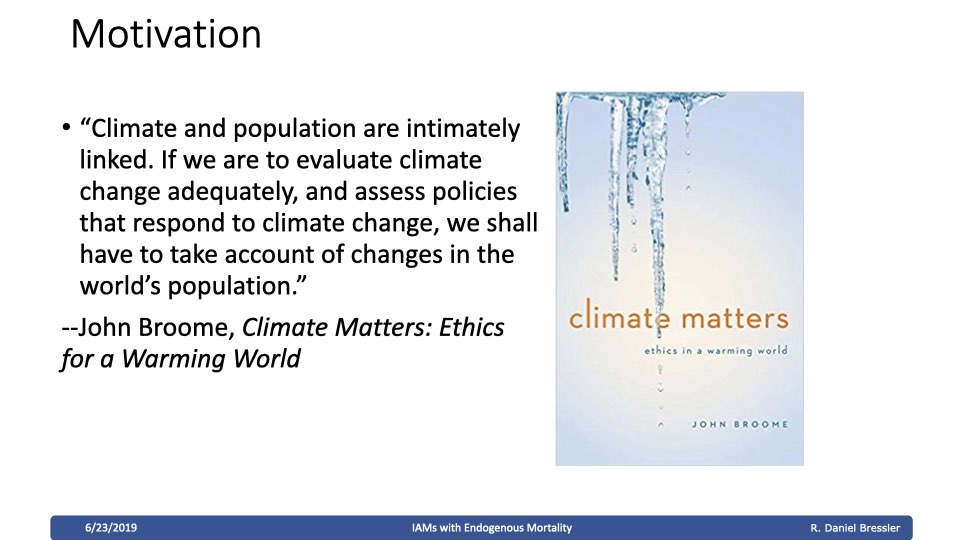
The [inspiration] for my research comes from a quote from John Broome, who is one of the leading philosophers studying climate. He says in Climate Matters: Ethics for a Warming World, “Climate and population are intimately linked. If we are to evaluate climate change adequately, and assess policies that respond to climate change, we shall have to take account of changes in the world's population.”
So I sought to answer a few questions:
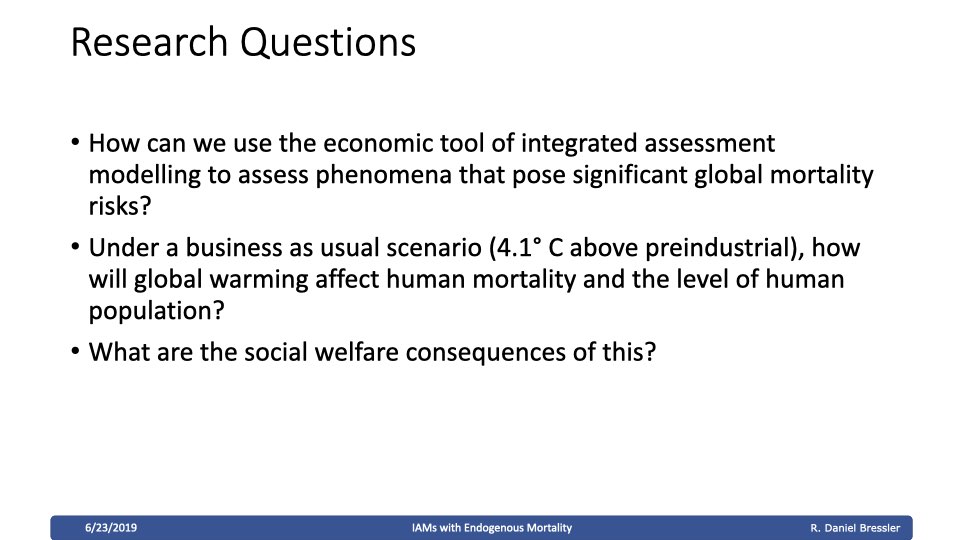
1. How can we use the economic tool of integrated assessment modeling to assess phenomena that pose significant global mortality risks under a business-as-usual scenario, which is 4.1 degrees Celsius above pre-industrial levels?
2. How will global warming affect human mortality and the level of human population?
3. What are the social welfare consequences of this?
Here is a preview of my findings:
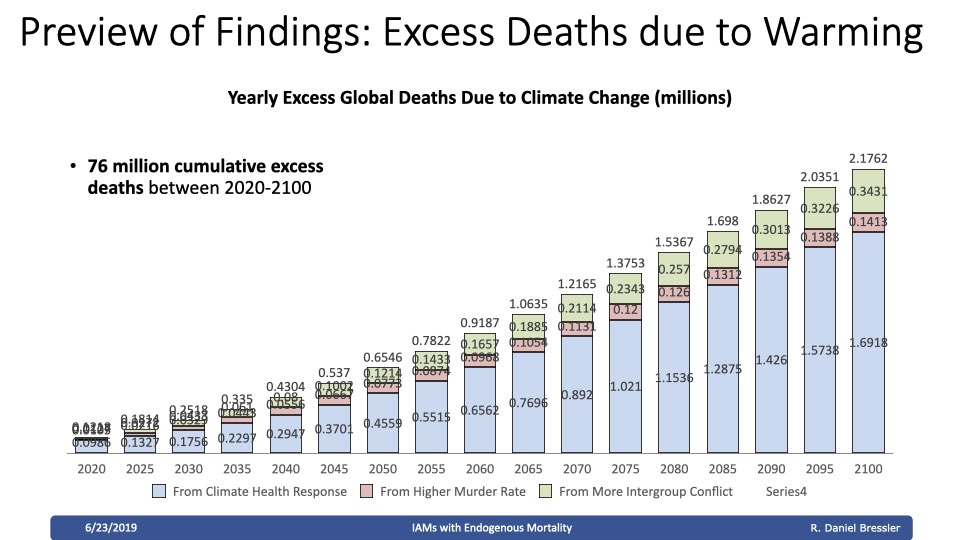
Over the next 80 years, there will be 76 million cumulative excess deaths. And by 2100, I project there will be 2.18 million yearly deaths through three channels (which I'll talk about in more detail shortly): the murder rate, the rate of intergroup conflict, and the social welfare impact.
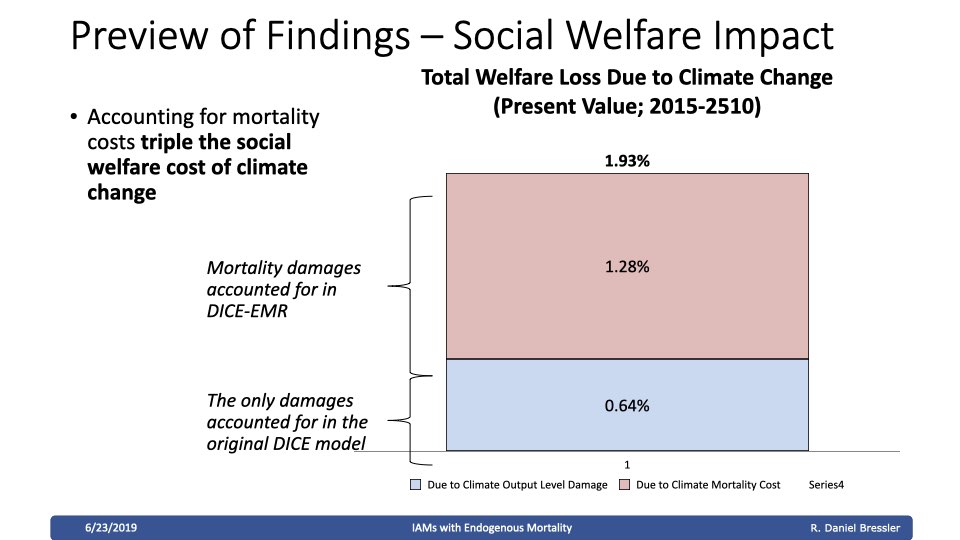
I expect that when we explicitly account for these mortality damages, the social welfare costs of climate change will triple. The original model that I'm building off of only accounts for damages to economic output.
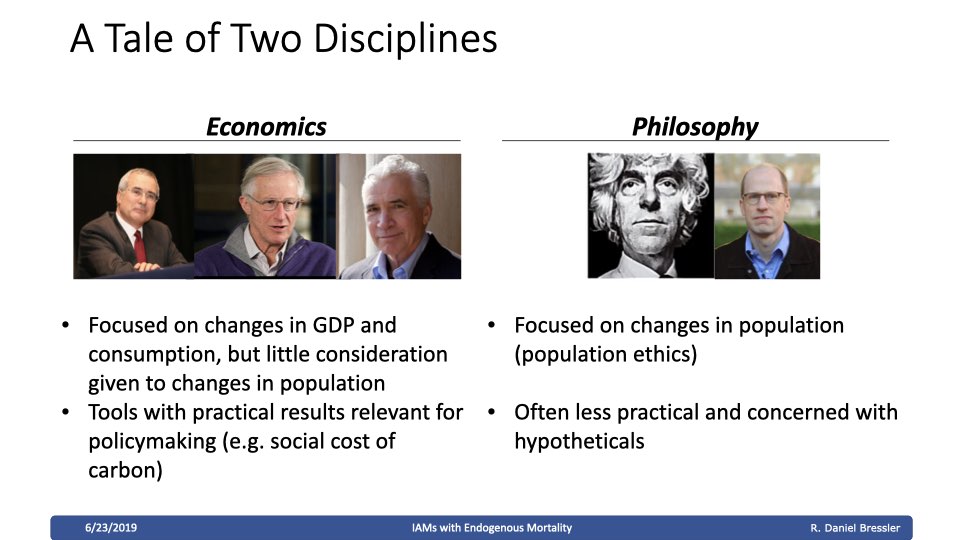
Let me take a step back to [view] this from an even higher level. I am primarily trained as an economist. And economists focus on changes in GDP and consumption. They usually don't think as much about changes to population. They do, however, produce tools that are practical and relevant for policy-making, such as [tools to calculate] the social cost of carbon. Three economists who all work [or worked] in climate change are Nick Stern, William Nordhaus, and Marty Weitzman [Weitzman died in August 2019].
In addition, I'm quite interested in philosophy. I have a fellowship with Oxford’s Global Priorities Institute, which brings together economists and philosophers to think about global priorities. And what I've noticed is that philosophers are quite interested in changes in population. There is a whole field [devoted to] this called population ethics. Two philosophers working in that field are Derek Parfit and Nick Bostrom.
What I've noticed is that philosophy is often less practical and more concerned with hypotheticals [than economics]. There are certainly exceptions to that. But I think it's fair to say that economists, on the whole, probably have a larger influence on policy-making. So the goal of this project is to bring together the concerns of philosophy — which include changes in population — and the practical tools used in economics.
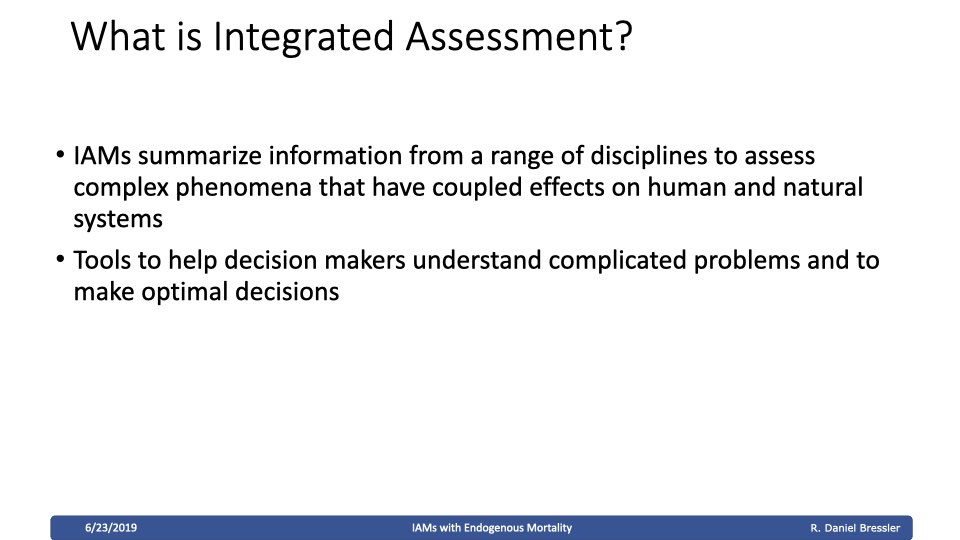
What is integrated assessment? Integrated assessment models summarize information from a range of disciplines to assess complex phenomena that have coupled effects on humans and natural systems. There are tools to help decision-makers understand complicated problems and make optimal decisions. This past year, William Nordhaus won the Nobel Prize primarily for his work on integrated assessment modeling.
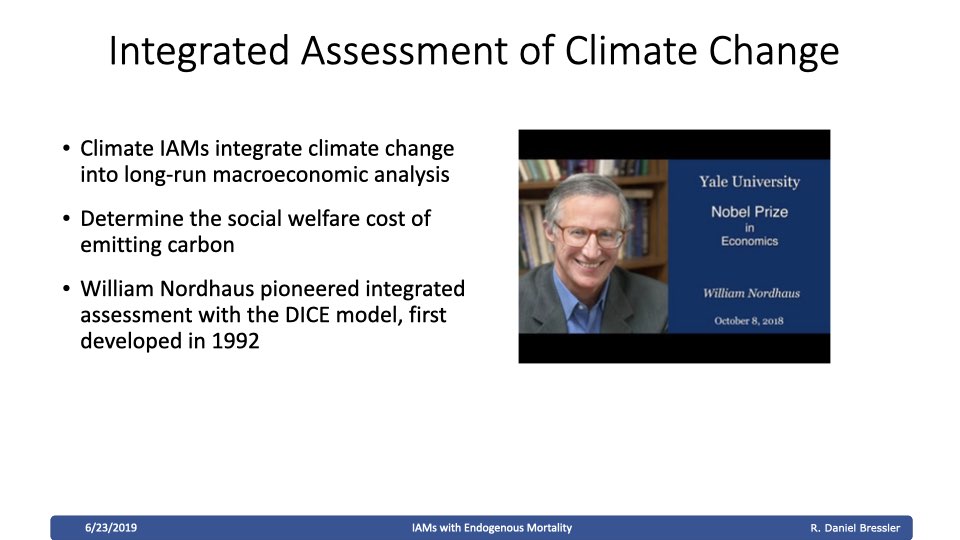
Climate integrated assessment models integrate climate change into long-term economic analysis. They determine the social welfare cost of emitting carbon. Nordhaus pioneered integrated assessment modeling when he developed the DICE model, which stands for “dynamic integrated climate-economy model.” It was first developed in 1992.
The DICE-EMR framework
My model is an extension to the DICE model. I will cover how these types of models and my extension work together. This is integrated assessment modeling in a nutshell:
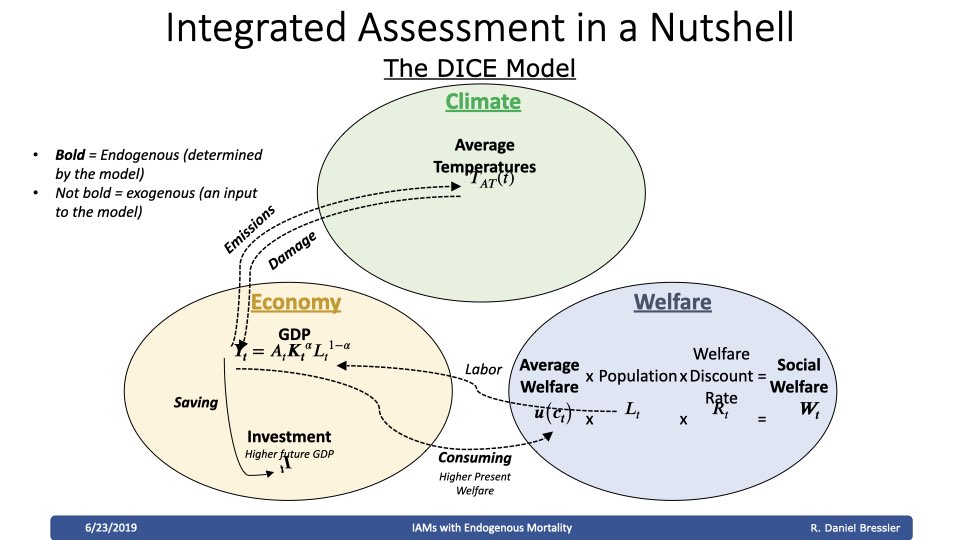
As you can see, there's a model of economic systems, combined with a model of social welfare, combined with a model of climate.
Let's take a slightly deeper dive into the math, starting with the economy. There's a projection of the amount of GDP, which is a function of capital, labor, and total-factor productivity. And then there's investment. More investment leads to a higher GDP in the future, but agents also need to choose how much to consume. Consumption affects welfare. So the average social welfare in the economy, in this model, is a utility function, which is a function of consumption. Then you multiply that by population, then by a welfare discount rate. You aggregate the result across time, and you're left with the social welfare function. So, ignoring the climate piece for a moment, the bottom two systems on this graph — the economy and social welfare — make up the standard neoclassical growth model in economics.
What William Nordhaus did was add on the climate system. The economy affects the climate because there's a certain fraction of economic outputs that might change over time, in terms of emissions per unit of GDP. That affects global average temperatures. But as the world gets warmer, there are damages to the levels of economic output. There's a feedback system between the economy and the climate. So, at a very high level, this is how the DICE model works.
But I think there's something missing in this model.
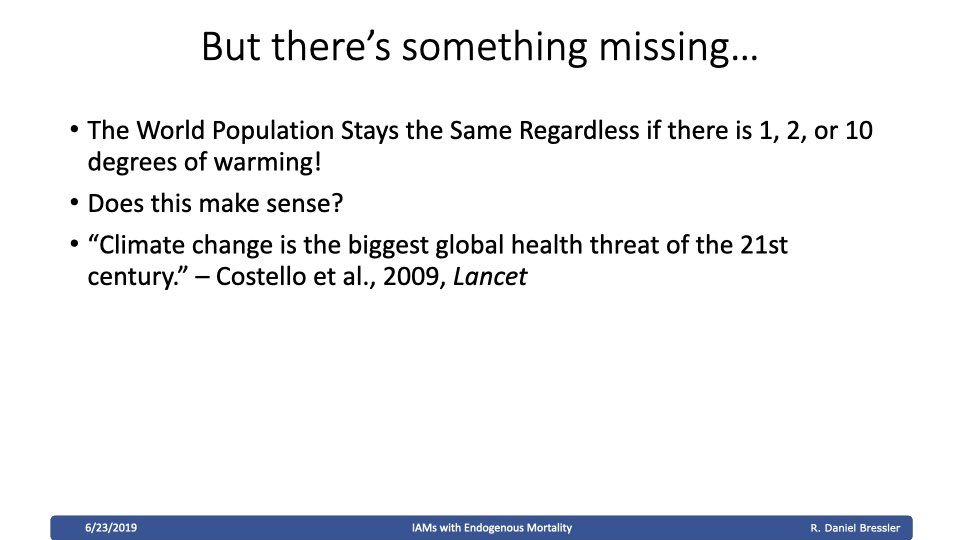
The world population stays the same regardless of whether there's one degree of warming, two degrees of warming, or ten degrees of warming. Does this make sense? A lot of recent literature suggests probably not.
An article in the Lancet suggests that climate change is the biggest global health threat of the 21st century.
Let's dive into some of this literature. This is a projection of the effect that climate change is likely to have on different types of days — from very hot to very cold days.
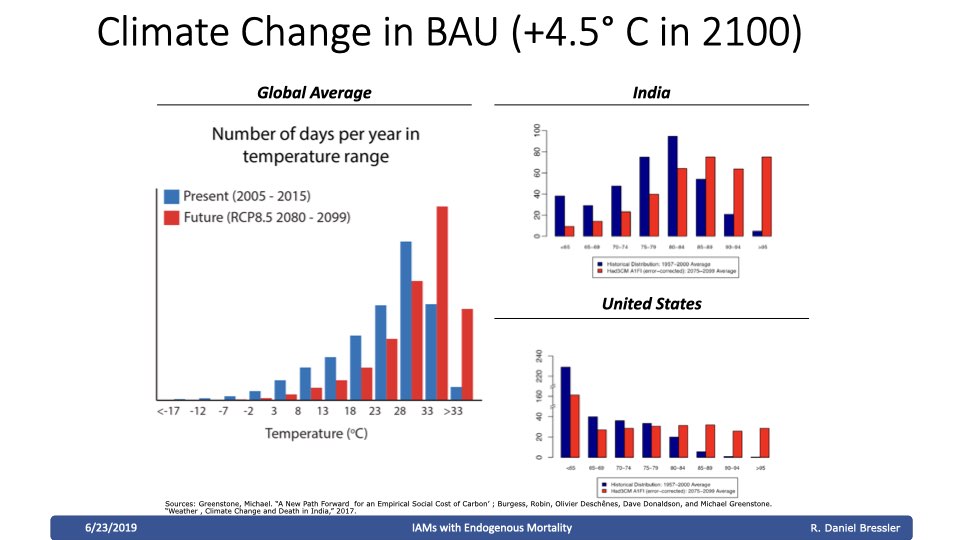
This shows the average for the whole world right now, with the highest number of days in the “28 degrees Celsius” range. There are not a lot of super-hot days over 33 degrees Celsius. But under a scenario in 2100, with about 4.5 degrees Celsius of warming, the number of hot days is expected to skyrocket, with many days between 20 and 33 degrees Celsius, and even over 33 degrees Celsius. We can see that this will happen both in warmer places and in slightly colder places.
So in India, which is already a fairly hot place, the most common daily temperature is between 80 and 84 degrees Fahrenheit. There are currently very few days over 95 degrees Fahrenheit. But under this scenario, there are going to be many more days over 95 degrees Fahrenheit. Something similar will happen in the United States.
What's the effect of this warming trend? Fortunately, [researchers have produced] a lot of empirical literature on this topic over the last few years. This is just a snippet from This is just a snippet from a 2011 paper by Deschenes and Greenstone.
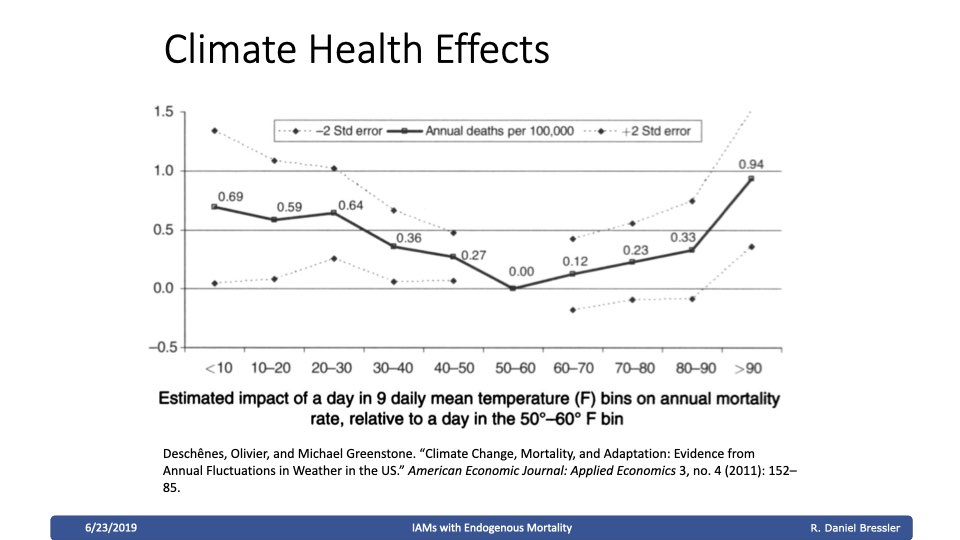
They looked at the effect of different types of days on the overall mortality rate in the United States. If there is a really hot day over 90 degrees Fahrenheit, we would expect there to be an additional death per 100,000 over the course of a year relative to a milder day of 50 to 60 degrees Fahrenheit. Colder days have a mortality effect, but there's a very pronounced mortality effect over 90 degrees Fahrenheit.
This is a more recent study by Fu et al. from 2018 that looked at the effect in India.
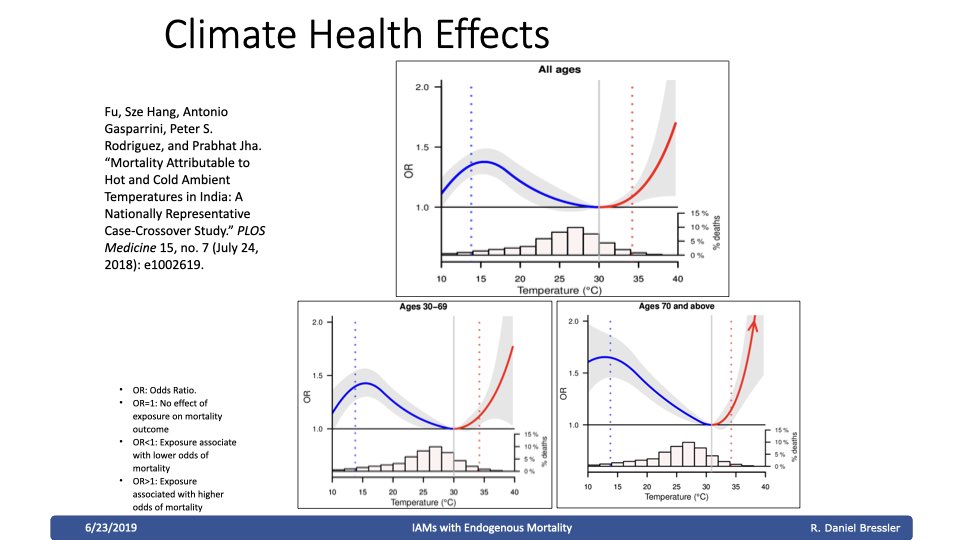
As you can see, if there's a very hot day of 40 degrees Celsius or more, the odds of mortality go up significantly. We see this happen in both middle-aged people, who are 30 to 69 years old, and older people.
Those are the health effects of climate change.
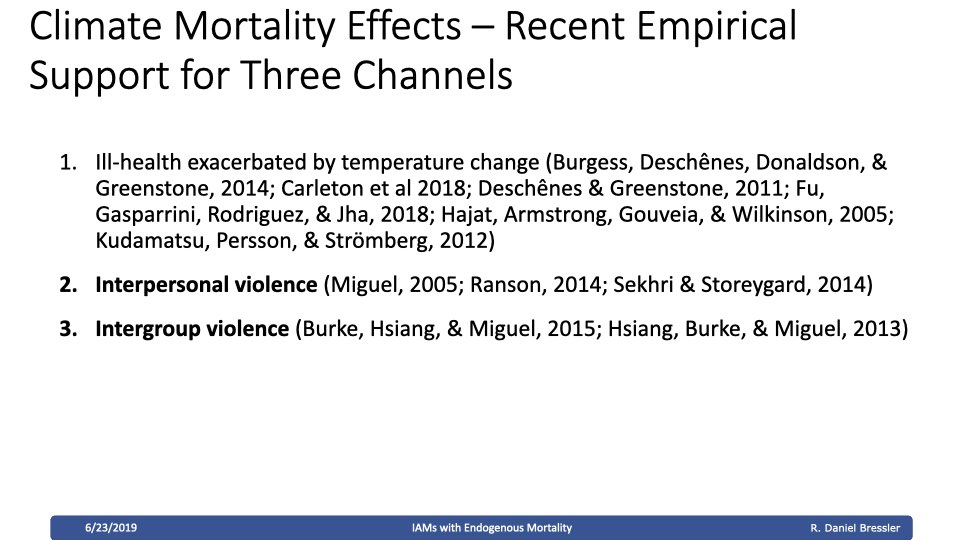
There have been other significant mortality effects of climate change surveyed in the literature. There are effects from interpersonal violence as well as from intergroup violence. A [metareview came out in 2013 by Hsiang, Burke, and Miguel](https://science.sciencemag.org/content/341/6151/1235367/tab-figures-data).
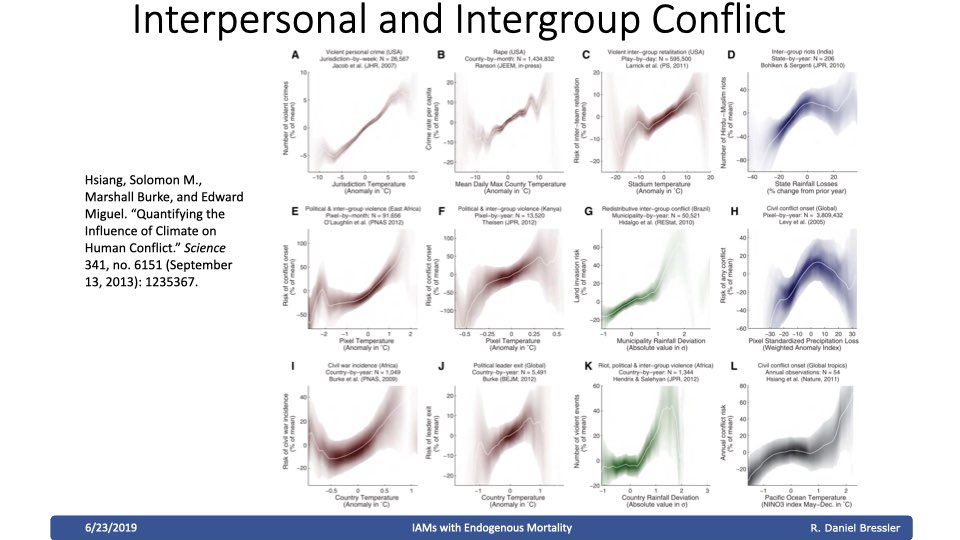
They reviewed 60 different studies on the effects of temperature on conflict — from crimes like rapes to higher-level conflicts like civil wars and political leader exits — and they found an overwhelming consistency across all of the findings. Twenty-seven out of twenty-seven of the modern studies [on this topic] found that increased temperatures result in an increase in the rate of interpersonal conflicts.
Let's go back to the DICE model:
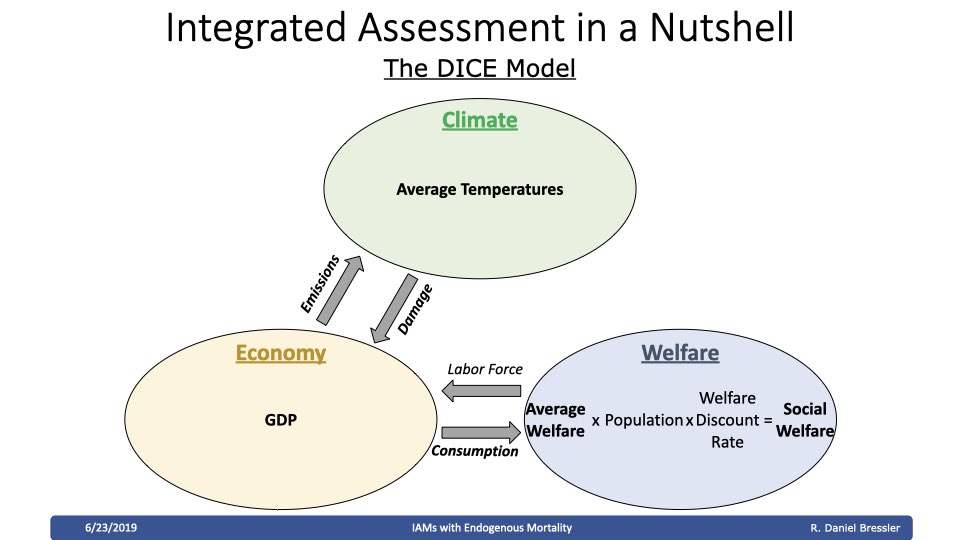
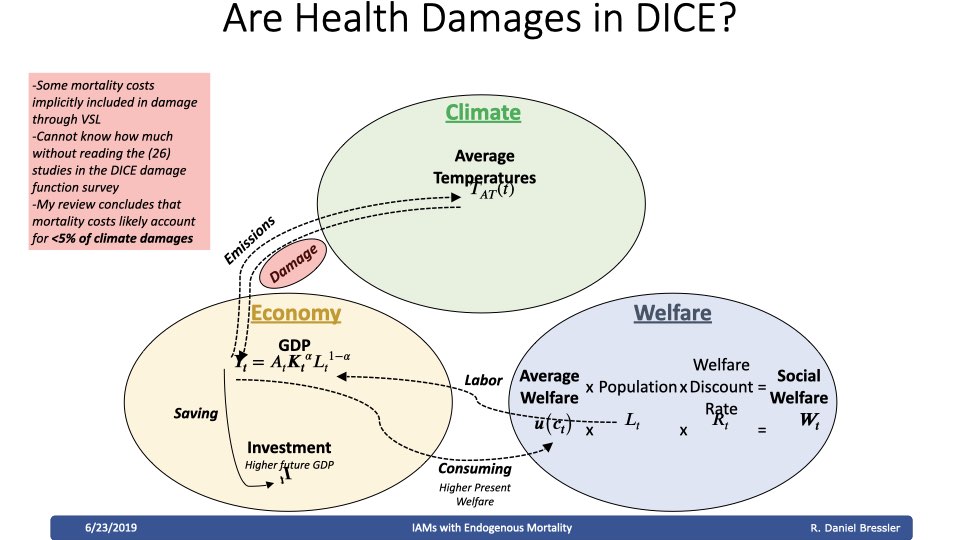
Are health damages included in DICE as it currently exists? In theory, some non-market damages (which include health damages) are supposed to be implicitly included within the model’s “damage” function, through a method called “value of statistical life.” However, the degree to which they are included is very hard to know without looking at the individual studies surveyed in order to create the damage function.
There are twenty-six of these studies. What I did is look at the studies that received the most weight. I tried to determine to what extent mortality costs were included. And what I found was that some of the studies didn't include mortality costs at all. Some of them included them as a small percentage. But none of them [had these costs accounting for more than 10% of the damage function]. I concluded that, [across the collected studies], less than 5% of this damage function is made up of health damages.
So the answer to the question [of whether DICE accounts for health damages] is yes — but to a very small degree that is much less than the recent empirical literature would support.
So how do I deal with this issue? I added an additional system to DICE.
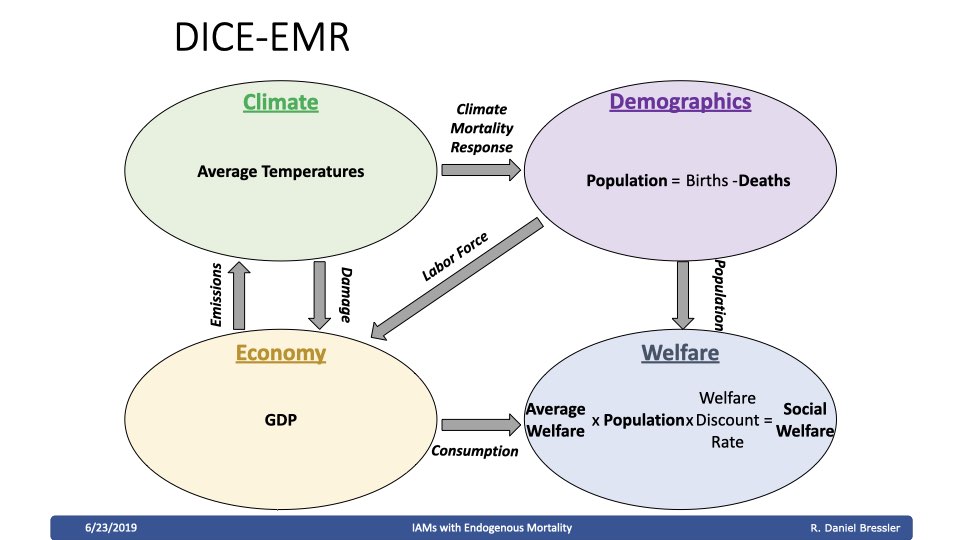
DICE was previously made up of three systems: climate, economy, and social welfare. Those largely remain the same as they were before, but I add demographics. Human population is a function of births and deaths annually that determine the population. And then there is a mortality response, such that higher average temperatures affect the mortality rate. That's why this model is called DICE-EMR, with an endogenous mortality response.
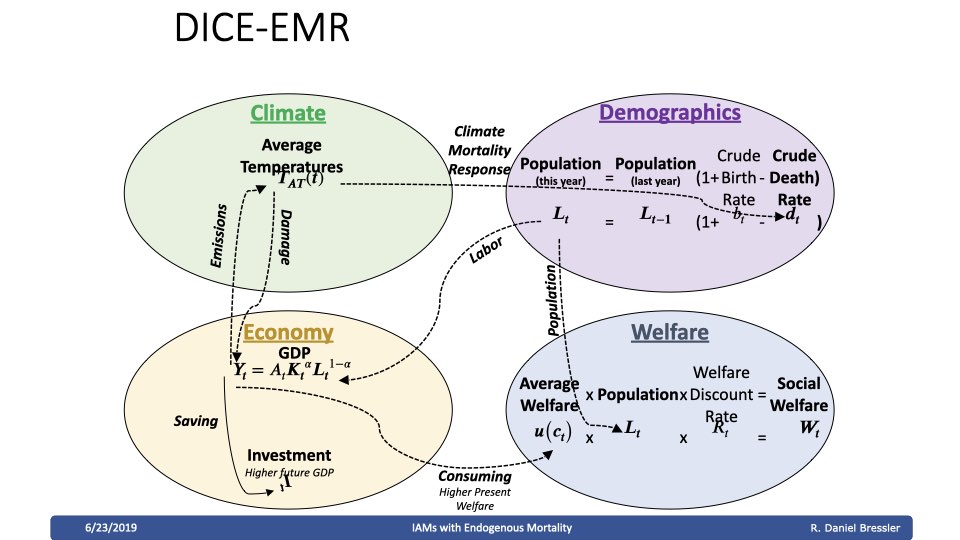
Let's look more closely at the math. Everything is largely the same as before with climate, economy, and welfare. But now the crude death rate [and, by extension, the population] are affected by the average temperatures through those three channels. This will have downstream effects on the GDP, because labor is a determinant of total GDP. It will also have downstream effects on welfare, because population is a key determinant of the amount of welfare in the system.
How do I isolate the effect of the EMR? I use an “opportunity cost of life” methodology.
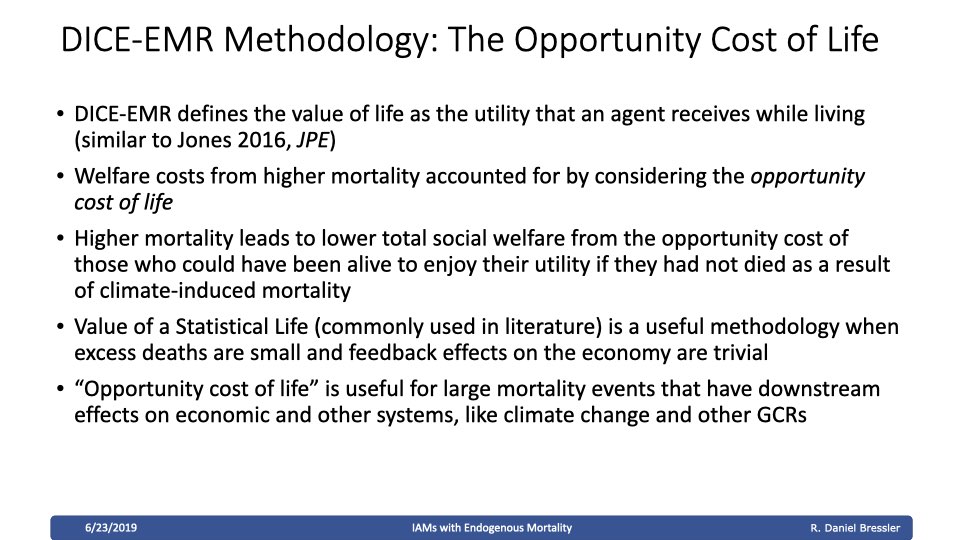
I define the value of life as the utility that an agent receives while living. Therefore, the welfare costs from higher mortality are accounted for by considering the opportunity cost of that life. Higher mortality leads to lower total social welfare, because those who die as a result of climate-induced mortality would have otherwise lived to enjoy their utility.
The value of statistical life that's commonly used in the literature is useful when excess deaths are small and feedback effects on the rest of the economy are trivial. But in this instance, the feedback effects are larger.
Methods
Let me turn to the methods. I’ll go through this section quickly; [I plan to produce and share] a working paper in the relatively near future. [Editor's note: Daniel's working paper is available here.]
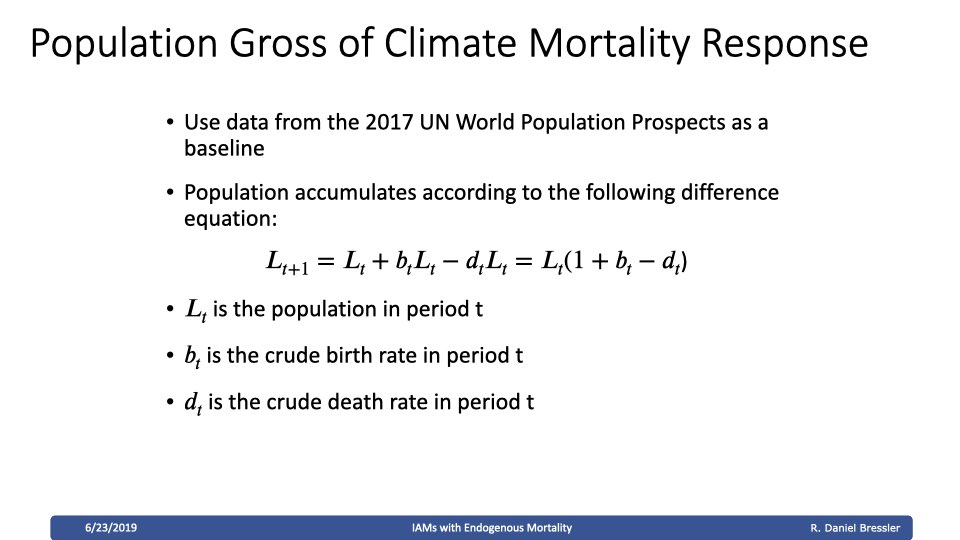
There is a standard way of calculating how population changes over time, which is a function of birth rates and death rates.
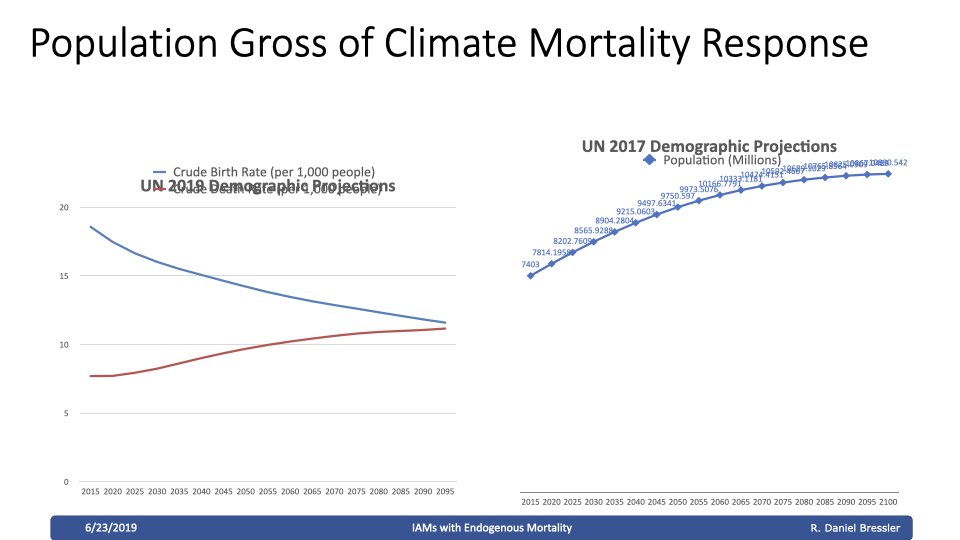
I use projections from the United Nations of crude global birth and death rates in the future. There's a demographic transition that's happening and is expected to continue as people choose to have fewer children, and as the world gets healthier and wealthier. At the same time, there will be a slightly higher crude death rate, because the world is aging. So, there will be a projected 10.9 billion people by the end of the century.
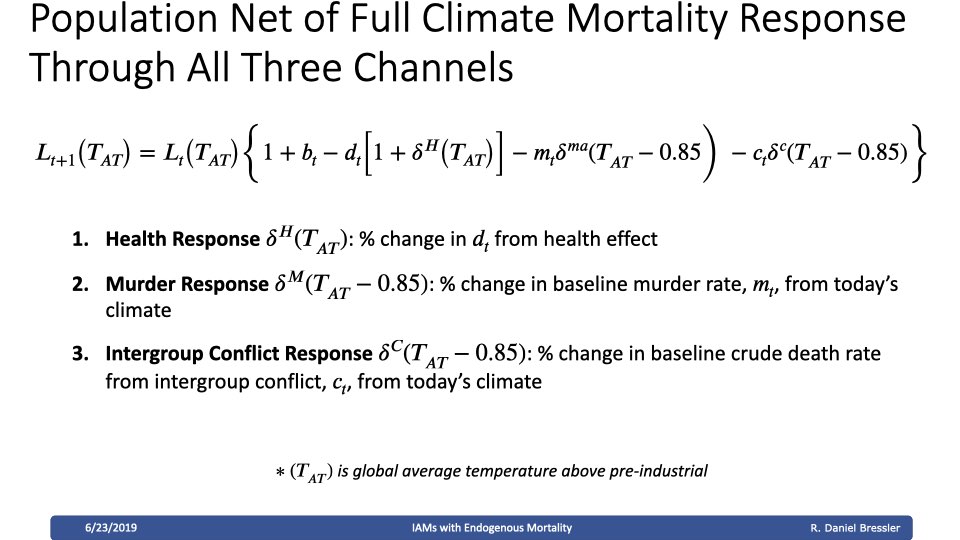
Essentially, I'm trying to understand how the mortality rate will affect the level of population. There are three different channels to consider: a health response, a murder response, and an intergroup conflict response.
Let's start with the health channel.
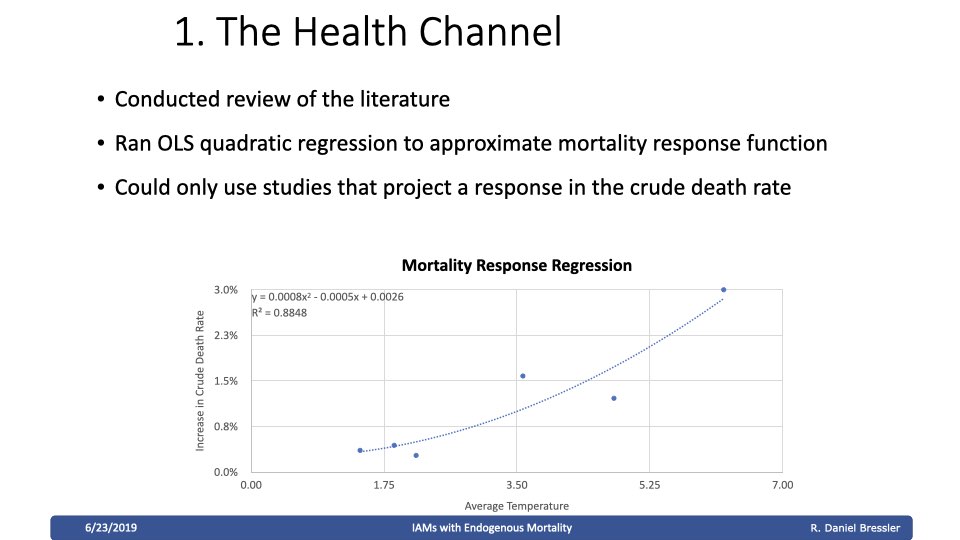
I conducted a review of the literature to find estimates of how different temperatures are expected to increase the crude death rate. I then ran an OLS [ordinary least-squares] quadratic regression to estimate the response function of how the crude death rate responds to increases in average temperatures.
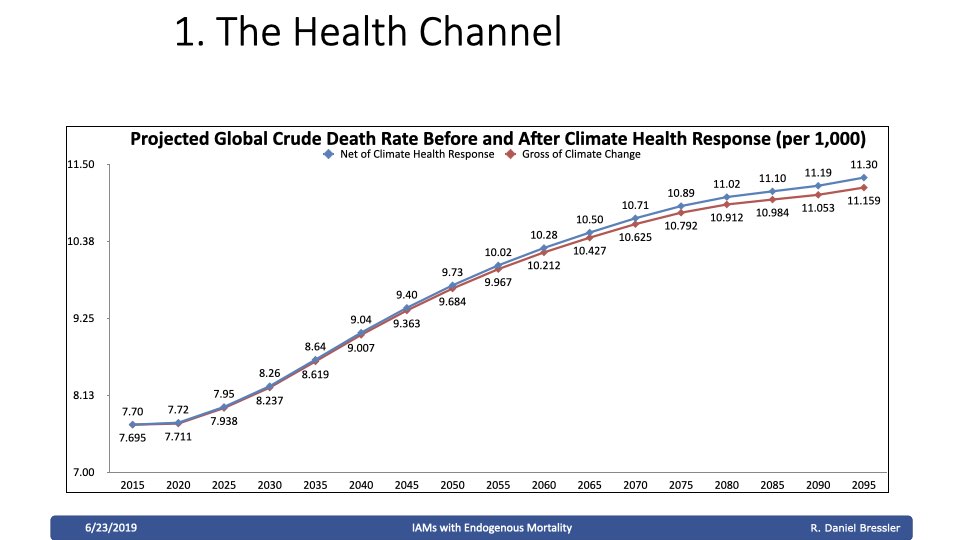
As you can see, I project a new, slightly higher crude death rate. It doesn't look like a huge amount, but we've already seen that the overall consequences [are significant].
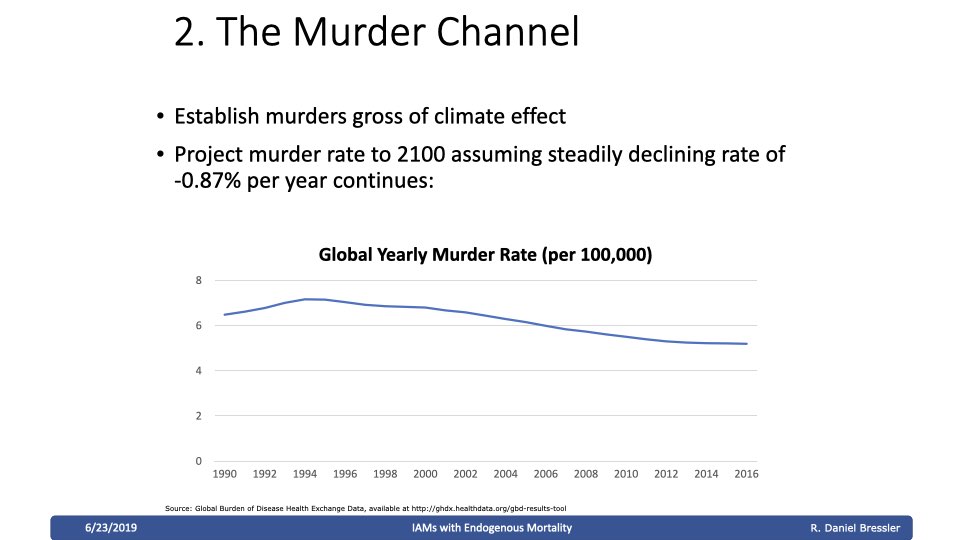
For the murder channel, I established the gross number of murders through the year 2100, [irrespective] of the climate effect. I used Global Burden of Disease data on the yearly murder rate per 100,000 people. It has been going down slightly. I projected that to continue into the future, represented by the bottom line [on the slide].
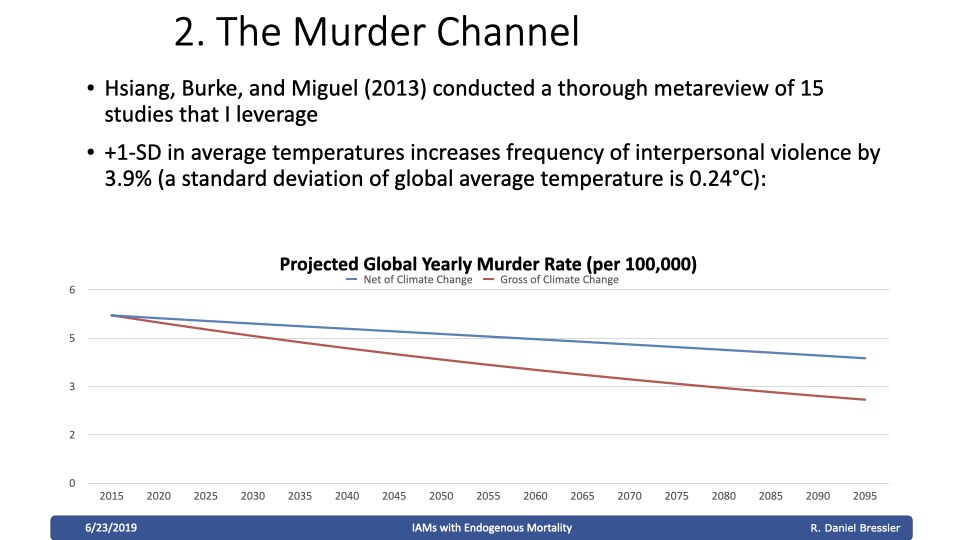
Then, I used Hsiang, Burke and Miguel’s metareview to look at the effect of warming. They project that for every standard deviation increase in average temperatures, there will be a 3.9% increase in the rate of interpersonal violence.
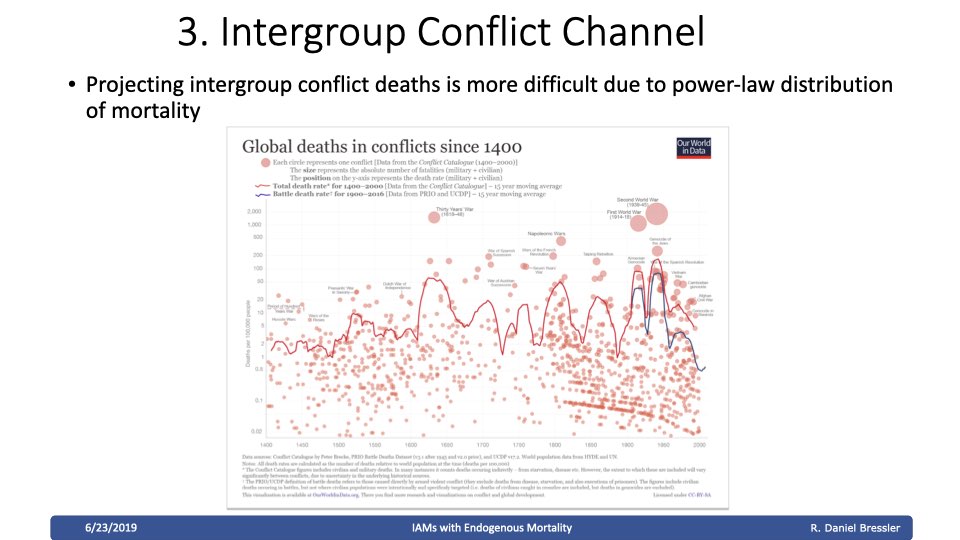
Finally, the intergroup conflict channel was the hardest to estimate, because mortality from intergroup conflict, or war, varies greatly over time. It follows a power-law distribution. You can see that during the height of World War II, the mortality rate was 200 per 100,000 people from conflicts. Today it's under two [people per 100,000]. So, the outliers — the large world wars — are the [main drivers] of the death rate through conflict.
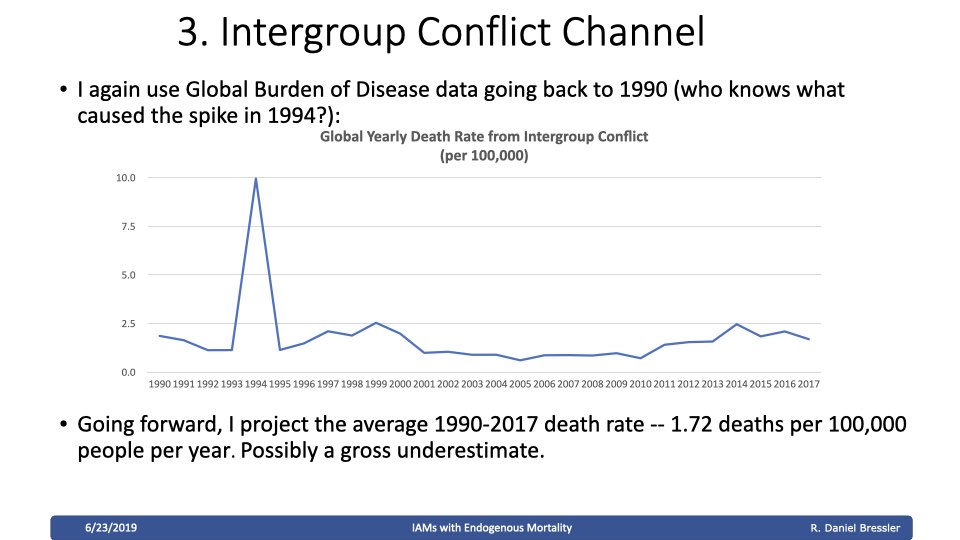
What I’ve done is to conclude that over the last 27 years, there have been an average of 1.72 deaths [per 100,000 people]. And I project that going forward. This is probably a gross underestimate. Even so, there's still a pretty big effect.
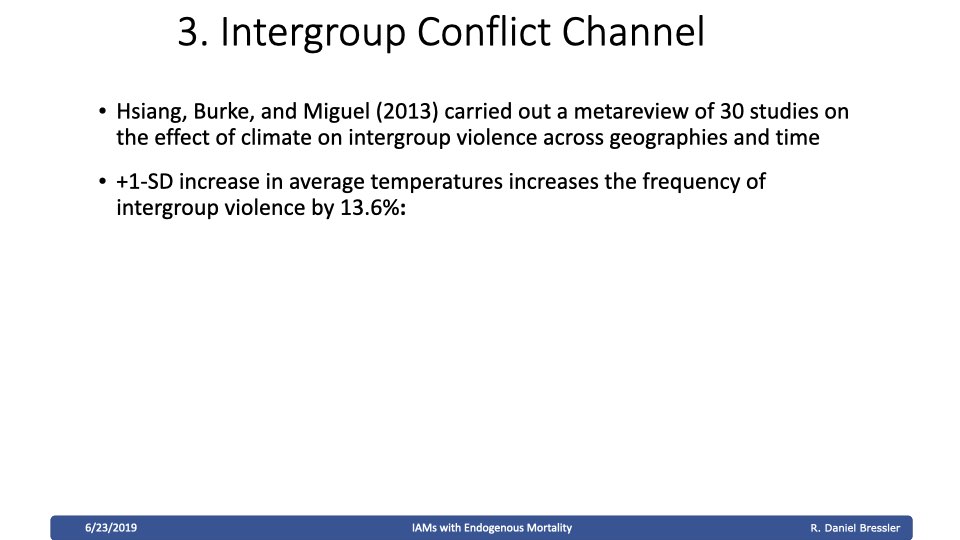
Next, I use Hsiang, Burke and Miguel’s meta-review of 30 studies again. They specifically looked at intergroup conflict and found that for every standard deviation increase in average temperatures, the frequency of intergroup violence increases by 13.6%.
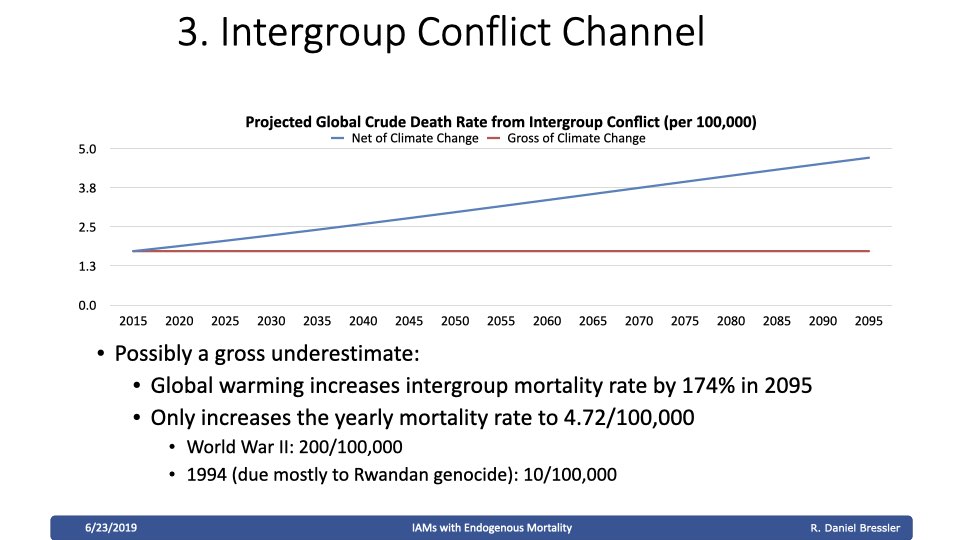
[On this slide,] the bottom line does not factor in the effect of warming on intergroup conflict). And the blue line factors in climate change. The rate of intergroup conflict increases significantly in percentage terms.
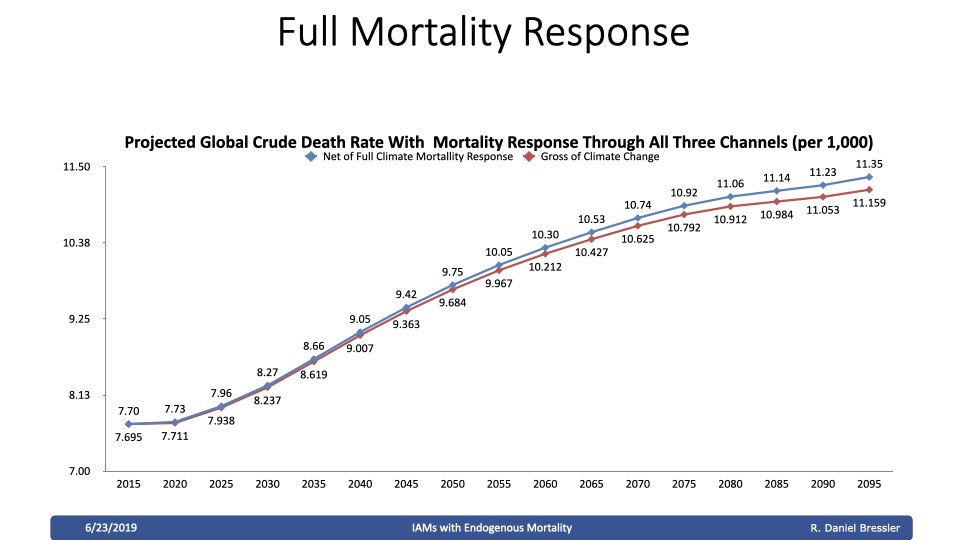
But because I took a fairly conservative approach to estimating the number that does not factor in climate change, by the end of the century the mortality rate is only 4.72 per 100,000, even with this warming response. It was 10 [per 100,000] during the Rwandan genocide, which was a bit of an outlier.
This next slide shows the full effect on the crude death rate:
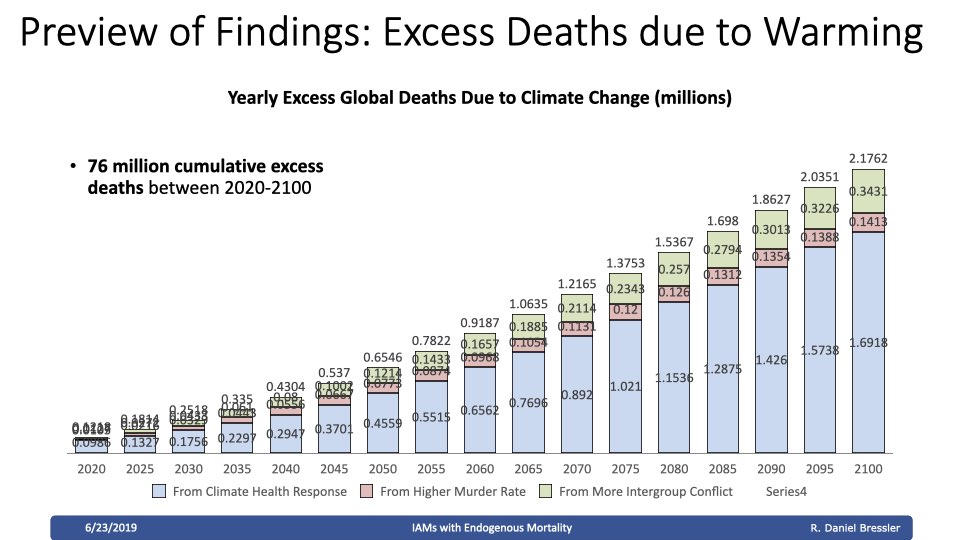
Results
I’ve projected there will be 76 million cumulative excess deaths over the next 80 years. And in the year 2100, I expect that there will be 2.18 million excess deaths. Most of them will come through the health channel.
This is the effect on the overall population:
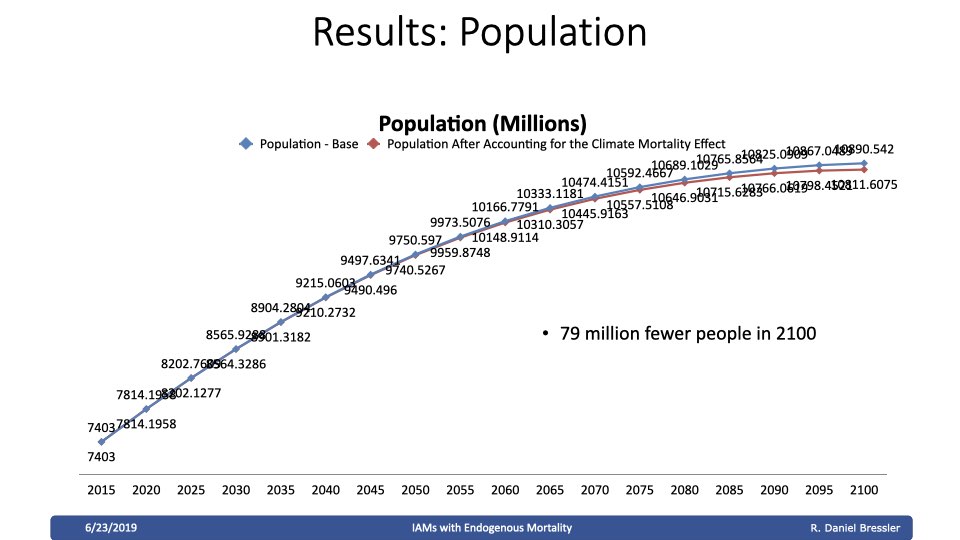
The United Nations projects that the population, without accounting for climate, is close to 10.9 billion. With the climate effect, it's closer to 10.8 billion.
This shows the economic effect:
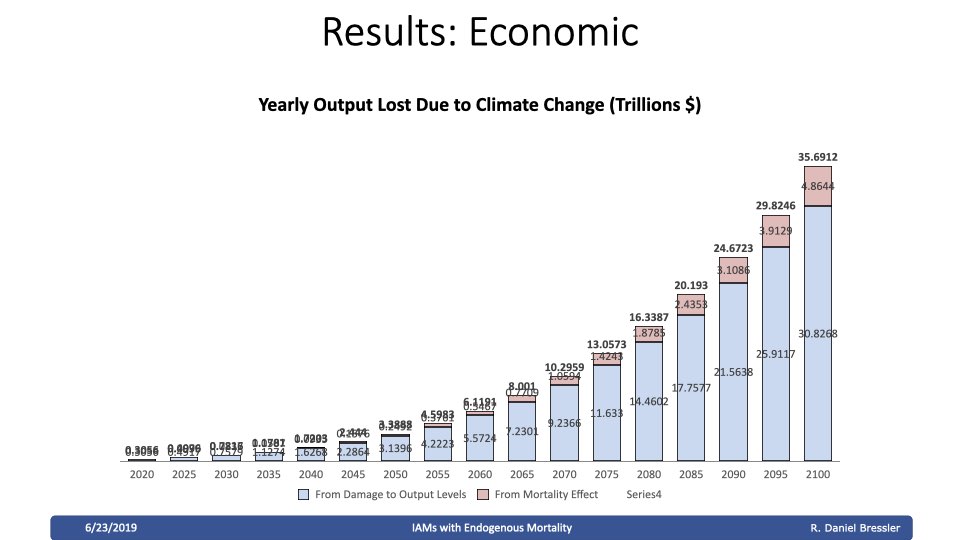
The original DICE model accounts for the damage of climate change to levels of economic output. That’s accounted for in the blue bars. But the red bars show the additional damage to economic output that comes from the mortality effects, because the labor force is one of the determinants of overall economic production. With a slightly smaller labor force, one would expect slightly lower output. But it is not trivial.
This slide shows the overall welfare effect:
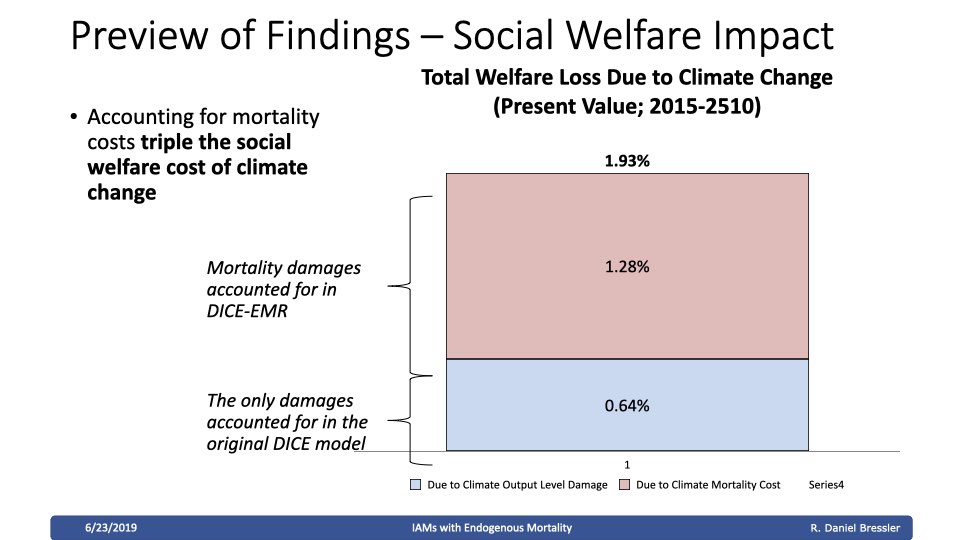
Over the next 500 years, we expect the present value of the social costs of climate change to triple when we account for these mortality damages.
Next steps
[Turning to] next steps, as I mentioned, there's good reason to believe that the way I chose to model intergroup conflict could have led to a significant underestimate. In the future, I might be able to do some stochastic modeling with an underlying probability of great power conflict increased by climate. I could see how that affects mortality.
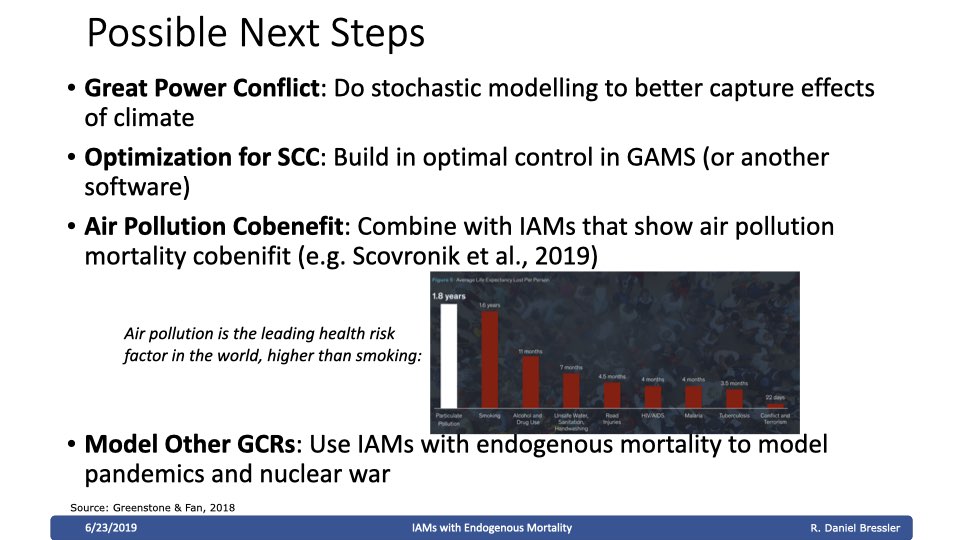
One thing I will definitely do is determine how to optimize this whole model to determine a well-defined social cost of carbon. This is commonly done. You determine, for every additional ton of carbon dioxide released, the full and present value of that carbon’s damage. I plan to do this over the next few months.
Something else to add in is the air pollution co-benefit of climate policy. Many people do not realize that air pollution, which is mostly particulate matter, is the leading health risk in the world. It is even worse than smoking. On this graph, you can see that, on average, particulate pollution reduces life expectancy by 1.8 years. That is significant. Combining this [data with findings from] a recent paper that came out [by Scovronick et al.] could be a good thing to do.
Finally, I could model other global catastrophic risks, such as pandemics or nuclear war. What might this look like? Here is an example of how you might use this methodology to think about a pandemic:
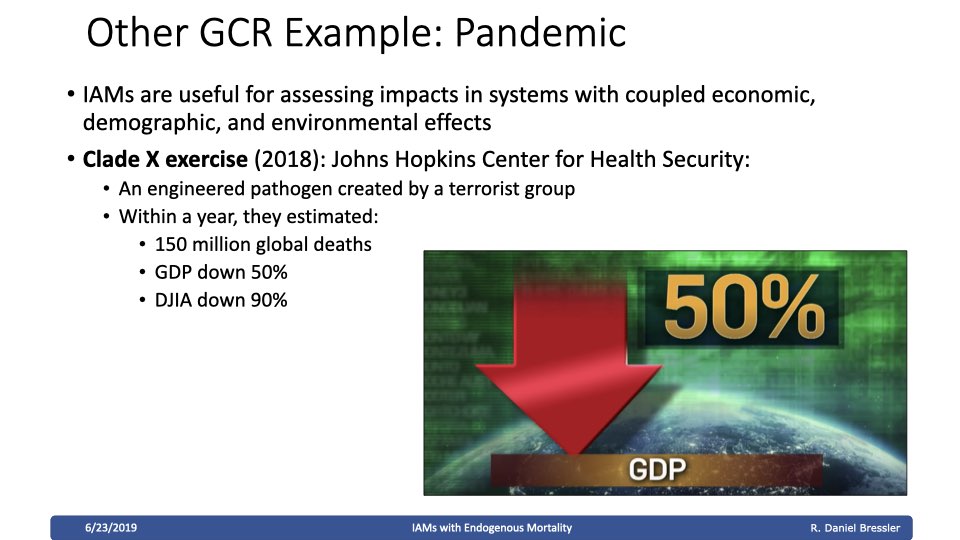
Integrated assessment models are useful for assessing impacts and systems with coupled economic, demographic, and environmental effects. There was an exercise [Clade X] that the John Hopkins Center for Health Security did last year. They projected that if a terrorist group engineered a pathogen, there would be 150 million global deaths, U.S. GDP would decrease by 50%, and the Dow Jones Industrial Average would fall by 90%. Clearly, a pandemic is an example of another type of global catastrophic risk that has significant mortality and economic effects. Using integrated assessment modeling — especially now that I've created a methodology to account for changes in population — could be useful.
I haven't done any of this work yet, but here is a sketch of what it might look like:
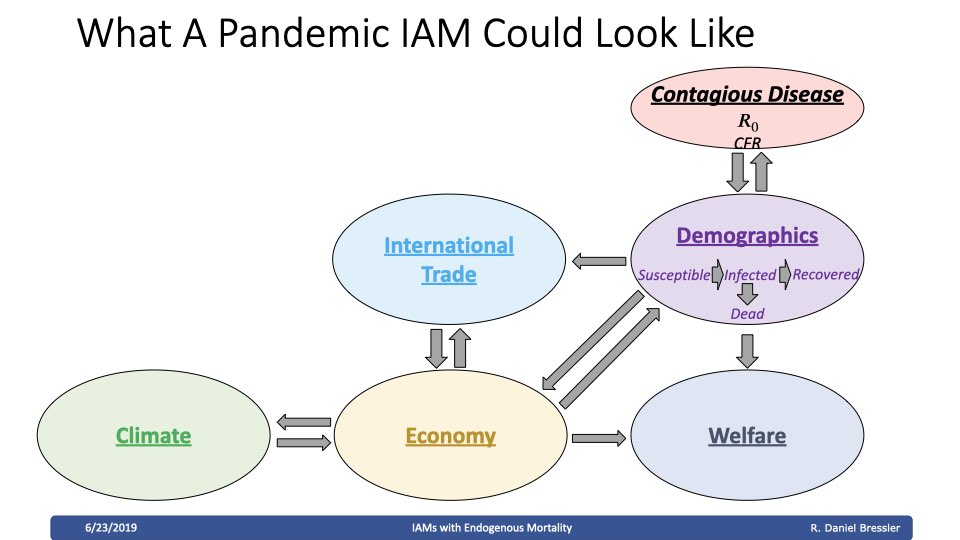
A contagious disease would affect demographics — for example, through the reproduction rate. Using a standard disease model, what's called the SIR model, [we can project] there would be effects on the economy due to a smaller labor force. People might stay at home because they would be worried about contracting the disease. It also could affect international trade, with borders closing down. And if the economy were to contract by 50%, that would have a significant effect on climate. All of these things would feed into one another.
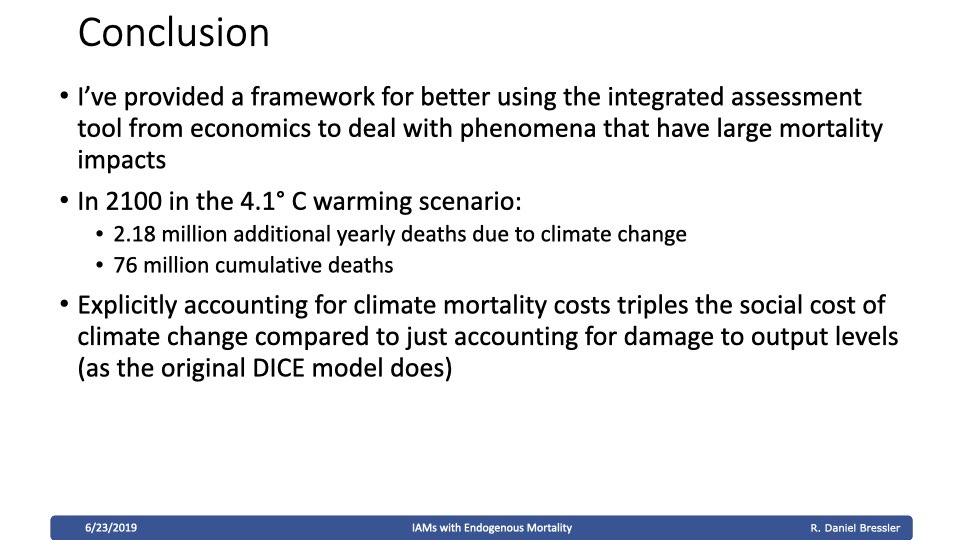
To wrap up, I have provided a framework for better using the integrated assessment tool from economics to deal with phenomena that have large mortality impacts. In 2100, under a 4.1 degrees Celsius warming scenario, I project 2.18 million additional yearly deaths due to climate change and 76 million cumulative deaths. And I find that explicitly accounting for human mortality triples the social cost of climate change, compared to just accounting for damages to output levels. Thank you.
Q&A
Phil Trammell (Discussant): Thank you, Danny. I think this is really well done and a useful extension of the DICE model, incorporating something that's been far too long neglected by economists: the effects on population.
I’m wondering if you could respond to a few quibbles I had when looking through your paper. When you introduce the studied relationship between temperature and the murder rate, you show what is present in the Hsiang, Miguel and Burke paper. They study temperature anomalies. They don't study the effect of slow, gradual changes in temperatures on the murder rate in the region. They say if there was a particularly hot summer, the murder rate was a bit higher. And that seems quite different from the case we face when we're projecting a slow climate change over a century.
Daniel: Yeah. Burke, Miguel, and Hsiang looked at studies across a range of timescales. Some of them were over shorter time periods. Some were over much longer time periods. And they found similar effects. But I think that's a good point. In general, more literature on the effect of climate and conflict probably would be useful. That paper is now five or six years old. A more recent paper just came out in Nature, but it wasn't a statistical analysis in the same way [Hsiang, Burke, and Miguel’s paper] was.
Phil: It is my understanding that your estimate of the cumulative excess deaths due to climate change just takes the crude death rate from the United Nations (and Nordhaus then uses it in his DICE model).
Daniel: Yeah. He uses an older version. The new one came four days ago.
Phil: Right. So, your model takes those numbers and then it adds in the mortality effects from the three causes — ill health, interpersonal conflict, and intergroup conflict — as if they were additively separable. But of course, when the population is smaller due to one cause, [there is a cumulative effect]. For example, if there is a 10% temperature shock, it follows that 10% of the remaining 90% would result in 81% of the total population remaining. It would be a 19% cumulative [effect].
Daniel: You'd have to go to the appendix of my paper, but it accounts for that. The health response goes directly into the crude death rate, but then the murder response and the intergroup conflict response are modeled separately using the baseline that I projected. They're not directly affecting the crude death rate. They're added on after the fact. And then you can recalculate the overall crude death rate after you account for those two things separately.
Phil: Does that make sense? We can talk about it later.
Daniel: It’s possible I made a mistake. But it's in the appendix of the paper.
Phil: I think it would be great if this sort of methodology were applied to questions of more long-term importance, such as pandemics. I'm glad to see more steps in that direction.
Daniel: Thank you.
Moderator: We have time for one question from the audience. Daniel, I think you touched on this on your talk, but one audience member asks: Does temperature systematically affect birth rate as well as death rates?
Daniel: That's a great question. Yes. I don't specifically model it in this paper because it's not exactly clear what the direction of that might be based on the empirical literature. But it's in my appendix. There's a paper by Barreca, Deschenes, and Guldi that looked at the effect of temperature on the birth rate. They found that as temperatures increase, there is a significant decrease in birth rates.
But on the flip side, when there's a higher mortality rate following a disaster, the empirical literature suggests that there will be a higher birth rate to replace the people who died. So there are two different effects that go in opposite directions.
I only wanted to model phenomena whose effects, in the empirical literature, clearly went in one direction. But I think [birth rate] is important to consider, and it is something I would love to model when the empirical literature is more clear.